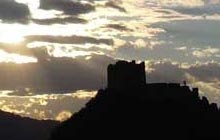
When you see this massive structure snaking its way across precipitous, rocky ridges, sometimes even lain across iron beams to bridge windy chasms, you will be amazed by the sheer scale of the undertaking. From the Bohai Sea in the East to Dunhuang’s desert plains in the West, the Great Wall stretches its knotted spine. Looking at it, perhaps you will wonder why.
From earliest times civilizations such as those of the Greeks and Hebrews enclosed their cities within a perimeter wall. In China during the fifth century BC, the Warring States took this concept one step further extending their walls to encircle entire territories. When Qinshihuang, the Qin dynasty Emperor, unified China, he joined the walls along the Northern frontier to prevent the incursions of the barbaric northern tribes. Thousands of slaves were sacrificed for the completion of this ambitious endeavor, and the Great Wall was viewed by the people as a symbol of tyrannical oppression. As subsequent dynasties expanded or contracted, so some sort of wall was built to delineate their Northern frontier.
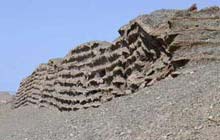
It wasn’t until after the Ming dynasty swept away Mongolian rule in the fifteenth century that the Great Wall was constructed as the regal and systematic fortification that you can see today. To understand the motivating reason for this Ming dynasty project, we must first review what it meant to undergo a Mongolian invasion. When the Horde burst out of the steppes a century earlier, this illiterate, nomadic tribe did not limit itself to the merciless murder, rape and pillage of people and cities. Such was their appetite for conquest that the wild nomads even burned their mark into vast swathes of cultivated farmland. The traumatic scar that these warring foreigners left on the Chinese psyche can today be measured in cubic meters according to the dimensions of the huge and incredible Great Wall of China.
The Ming dynasty’s effort to reinforce the wall was not in vain. The Great Wall was useful in checking the advance of the Manchu invaders in the seventeenth century. That the Ming finally succumbed was not due to any failure in this fortification, but to the worldly guile of a ravishing Manchu princess. That, though, is another story.
Time has now washed the Great Wall clean of its tyrannical undertones. While some Chinese people gloomily regard it as a symbol of China’s insensitivity to new ideas, others prefer to view it as a remarkable, historical achievement. Richard Nixon ably summed up this view:
“This is a Great Wall and only a great people with a great past could have a great wall and such a great people with a such a great wall will surely have a great future.”
 Yong Le (r. 1402-1424), the third Ming Emperor, moved the capital of China back to Beijing in order to fortify Northern China against the continuing threat of the bellicose Mongols. It was he that razed the palaces of Kublai Khan, built over a century earlier, to redesign the Forbidden and Imperial Cities in their new location slightly to the south-east. Since then, with only minor interruptions, the Forbidden City has served as an exclusive seat of government. Just as commoners were not allowed to penetrate the Forbidden City under the Ming and Qing dynasties, today most citizens and foreigners are not permitted into the government conclave in Zhongnanhai.
Yong Le (r. 1402-1424), the third Ming Emperor, moved the capital of China back to Beijing in order to fortify Northern China against the continuing threat of the bellicose Mongols. It was he that razed the palaces of Kublai Khan, built over a century earlier, to redesign the Forbidden and Imperial Cities in their new location slightly to the south-east. Since then, with only minor interruptions, the Forbidden City has served as an exclusive seat of government. Just as commoners were not allowed to penetrate the Forbidden City under the Ming and Qing dynasties, today most citizens and foreigners are not permitted into the government conclave in Zhongnanhai.
The rule of the Emperor was legitimized through a code known as the Mandate of Heaven, which presumed that the Emperor owed his status to Heaven. When an Emperor and dynasty were deposed successfully, this was interpreted as being in line with a new will of heaven, for otherwise it would not have been allowed to occur. In this way, the exclusionary and privileged life of the Emperor behind the walls of the luxurious Forbidden City was legitimized. So it is that in the Forbidden City there are reputed to be 9,999.5 rooms; half a room short of 10,000 which, it is said, is what the original Jade Emperor possesses in his Heavenly Palace.
One of the major political developments under the Ming dynasty was the Emperor's greater involvement in the administration of China. Rather than delegate control to the Ministries, the Ming Emperors developed a complex Imperial bureaucracy, comprised mainly of eunuchs, to supervise the machinations of government. As a result, to accommodate this vast, internal administration, the Forbidden Palace had to be constructed on a hitherto unprecedented scale.
The architecture and design of the Forbidden City along a North South axis reflect its dual purpose of providing a suitable environment for both Imperial government and Imperial life. To the South the buildings are grandiose and formal, built on a scale to impress visiting dignitaries. As you wander further north into the Emperor's personal quarters, you will see smaller structures, reflecting the greater intimacy of the Emperor's private life. The division between the private and public quarters takes place about the Gate of Celestial Purity. To its south are the three formal reception halls of Supreme Harmony, Central Harmony and Preserved Harmony. To its north is the Empress's Palace of Celestial Purity, the Emperor's Palace of Terrestrial Tranquillity and between them, the Hall of Terrestrial and Celestial Union.
Thus, in Imperial times, seniority translated into geography: the more senior you were, the further north you were invited to advance. Whereas a visiting ambassador might only be allowed as far as the Hall of Supreme Harmony, the tallest building in Imperial Beijing, a King might be invited further north into the Hall of Preserved Harmony.
 Day One
Day One
Upon arrival at Beijing's Capital International Airport, you will be met at the gate by airport VIP staff who will lead you through immigration, baggage claim and customs. The remainder of the evening is at leisure. Treat yourself to a swim or spa treatment, take a stroll in the local neighborhood, or dine at one of our recommended restaurants (Raffles Hotel – Landmark Room).
Day Two
This morning we take you to one of ancient China's most sacred sites, the majestic Temple of Heaven. The afternoon's activities contrast colossal monuments of the past and present. After strolling across the impressive Tiananmen Square, an authoritative symbol of today's China, you will by awed by the majesty of the magnificent Forbidden City (as in Bertolucci's film "The Last Emperor"). Your tour here will include private access to the Emperor's private quarters, normally closed to the general public. (Please note that access to this site is controlled by local authorities, who may deny access on occasion. (B, L, D)
Day Three
Today you will visit the Great Wall which has fascinated generations of travelers. Whereas Genghis Khan contemplated it as a military obstacle, Richard Nixon saw it as one of humankind's greatest achievements. Spanning from the Gobi desert in the west to the Bohai Gulf in the east, it reaches as far back in time as the seventh century BCE and is being projected forwards as one of China's proudest symbols for the 2008 Olympics. While the utility and meaning of this defense mechanism has been contested by centuries of diplomats and invaders, its unprecedented scale will astonish you and its unexpected beauty will inspire you. You will be treated to a private banquet on the wall itself (weather permitting). (B, L, D)
Day Four 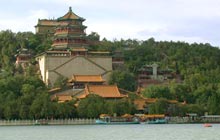
We begin with a pedicab tour through Beijing's historic alleyways (or hutong ). During this you will be afforded an insight into the everyday life of Beijingers. The hutongs ' intimacy contrasts with the poetic expanses you will see at our afternoon visit to the Summer Palace, a retreat built exclusively for the Dowager Empress Cixi. Its ornate temples, pavilions, and covered corridors, set amidst a graceful landscape, epitomize the refinement of this powerful matriarch. This evening's dinner perpetuates this sense of grace, leaving you with a wonderful memory of this Northern capital. (B, L, D)
Please note that B, L, D denotes Breakfast, Lunch Dinner.
The above itinerary is based on what past guests have generally enjoyed on a short visit to Beijing. No two guests are the same and while one might love to see the pandas at Beijing Zoo, another might prefer to hear a private lecture on Chinese literature in an elegant tea house. Please tell us your interests and we will customize an itinerary to suit. Guests who prefer to see more and rest less or who have more time to spend in Beijing, might choose to also visit the iconic Hutong neighborhoods, 798 Contemporary Art District, Lama and Confucius Temples, the West Qing Tombs or the East Qing Tombs. Note that these are only several of the additional sites in Beijing – you really could spend a couple of weeks here alone!
City tours are arranged on a private basis only. Visitors interested in a small-group tour of China, should view our frequent Imperial Tour itinerary.
 Xi'an and its surrounding area is at the very heart of China's history. This city served as the capital seat of twelve dynasties for more than 1100 years, and its Wei valley is the legendary birthplace of Chinese civilization. It was here that the mythical Yellow Emperor (third millennium BC) conquered the other warring tribes to give birth to the Chinese nation.
Xi'an and its surrounding area is at the very heart of China's history. This city served as the capital seat of twelve dynasties for more than 1100 years, and its Wei valley is the legendary birthplace of Chinese civilization. It was here that the mythical Yellow Emperor (third millennium BC) conquered the other warring tribes to give birth to the Chinese nation.
Over the centuries successive capitals have changed their names and locations, as well as their characters. The remains of Gaojing, the capital during the Western Zhou dynasty (1027-771 BC), consist of crude bronze artifacts for cooking, burial and farming. They reflect an early agricultural society. This is in contrast to the despotic Emperor Qinshihuang's (r. 221-207 BC) Xianyang, a capital city erected twenty-eight km west of modern day Xi'an. Built on a scale to befit such a tyrant, it came to be detested by the people as a symbol of his oppressive and short-lived regime.
The Western Han dynasty (206BC-8AD) moved the capital to within ten kilometres of Xi'an. It was during this prosperous period that Chang'an, as it was then known, rose to international prominence. A century after the opening of the Silk Road, Julius Caesar appeared one evening at the theater wearing a garment that caused a sensation – it was a silk robe from Chang'an. Silk, paper, tea, iron casting and irrigation were other inventions similarly exported to the West at this time.
After the Eastern Han dynasty (8-220 AD) transferred the imperial capital to Luoyang, it didn't return to Xi'an until China was once more reunified under the Sui dynasty (589-618). Once more the grandiose schemes of a despotic, conquering Emperor were curtailed by a dynasty more amenable to the people. During the golden age of the Tang dynasty (618-907), when China led the world in culture, technology and wealth, Chang'an became a focus for new ideas. A vast and splendid city of eighty square km, only twenty less than today's industrialized city, it contained a two million strong population. So beautiful were its buildings and orderly its design that the Japanese used Chang'an as the model for the still extant, smaller cities of Kyoto and Nara.
As the Tang Emperors pushed back China's frontiers more and more cultures from Central Asia, India and Persia were absorbed into the cosmopolitan capital. Besides the especially strong Buddhist community, there were also Zoroastrian, Muslim, Manichaean and Nestorian ones. The town thronged to the raucous rhythms of markets, taverns, workshops, and even polo matches.
 Renowned for its numerous gardens and canals, Suzhou is frequently mislabeled as the "Venice of the East". Its size and trading volumes though once significant nonetheless do not warrant such a grandiose comparison. Rather, it is best to think of Suzhou as the most distinguished of a multitude of canal towns, dotted around the Yangzi delta.
Renowned for its numerous gardens and canals, Suzhou is frequently mislabeled as the "Venice of the East". Its size and trading volumes though once significant nonetheless do not warrant such a grandiose comparison. Rather, it is best to think of Suzhou as the most distinguished of a multitude of canal towns, dotted around the Yangzi delta.
Suzhou's history dates back to the early seventh century BC at which time the semi-mythical ruler, He Lu, of the Kingdom of Wu is said to have founded the city. With the completion of the Grand Canal during the Sui dynasty (581-618 AD), Suzhou became a thriving commercial district as items such as silk were transported along the bustling waterways. Marco Polo recorded that its populace was comprised of "prudent merchants, and, as already observed, skilful in all the arts. They have also many persons learned in natural science, good physicians, and able philosophers."
During the Ming dynasty (1368 – 1644) with the increased concentration of silk manufacture here, Suzhou became an ever more fashionable cultural center. Thus by 1794, one of the members of Lord Macartney's ill-fated embassy to China described the town as having "(ruling) Chinese taste in matters of fashion and speech, and is the meeting place of the richest pleasure-seekers and gentlemen of leisure in China."
The city's good fortune ran out during the 1860's due to its occupation in the Taiping rebellion and then again in World War II by the Japanese. Today however, Suzhou is regaining its reputation for leisure as its visitors are afforded the rare opportunity to wander through the ancient gardens and homes of aristocrats, scholars and merchants. It is said that at one time, there were more than two hundred gardens in Suzhou. While not all of these still exist, some of the more famous such as those of the Humble Administrator and the Master of the Nets have been restored to their former beauty.
More recently, the city has been undergoing a new transformation. A Singaporean consortium, with the contribution of I.M. Pei, a Suzhou native, has helped to revive Suzhou's original architectural facade. Once more, Suzhou offers a parade of traditional white buildings and cobble-stoned walkways, lined with trees and flowering plants.
A further modern addition, indicative of the ingenious planning being invested in the city's renovation, is the newly built Sheraton Hotel. We will stop here for a dimsum lunch to admire the creative synthesis of traditional Chinese design with the demands of a modern luxury hotel.
 Shangri-La – is there another word so redolent of a utopia on the roof of the world? Since the publication of James Hilton's novel "Lost Horizon" in the 1930s, the western imagination has been gripped by the promise of an earthly paradise somewhere high in the Himalayas . Hilton had travelled in the region a few years before his novel was published, but never gave the exact location, and to this day it remains a mystery. (In a telling mirror image, Chinese culture has long been obsessed with a paradise somewhere to the West, near the Kunlun Mountains which run to the south of the Taklamakan Desert .) One of the present-day contenders for hosting this utopia was known in Chinese as Zhongdian County until 2002 when it officially changed its name to Shangri-La County . Its Tibetan name remains Gyalthang. Is this the real Shangri-La? You can form your own opinion, but it certainly has some of the necessary attributes. High up in the mountains at an altitude of over 10,000 feet, it is home to the Ganden Sumtseling Monastery in whose valley lie old Tibetan villages hinting at a pastoral utopia.
Shangri-La – is there another word so redolent of a utopia on the roof of the world? Since the publication of James Hilton's novel "Lost Horizon" in the 1930s, the western imagination has been gripped by the promise of an earthly paradise somewhere high in the Himalayas . Hilton had travelled in the region a few years before his novel was published, but never gave the exact location, and to this day it remains a mystery. (In a telling mirror image, Chinese culture has long been obsessed with a paradise somewhere to the West, near the Kunlun Mountains which run to the south of the Taklamakan Desert .) One of the present-day contenders for hosting this utopia was known in Chinese as Zhongdian County until 2002 when it officially changed its name to Shangri-La County . Its Tibetan name remains Gyalthang. Is this the real Shangri-La? You can form your own opinion, but it certainly has some of the necessary attributes. High up in the mountains at an altitude of over 10,000 feet, it is home to the Ganden Sumtseling Monastery in whose valley lie old Tibetan villages hinting at a pastoral utopia.
This modern-day Shangri-La did not begin life as a utopia, but was an important stop on the Tea and Horse Route that ran from Yunnan up into Tibet . South the path went down to Lijiang and the lower tea lands of Yunnan, while to the north the path skirted the magnificent Kawa Karpo Mountain, with its peak at over 20,000 feet, before heading into Tibet proper. Even today this route has been acknowledged as the best path from Yunnan into Tibet with the Chinese-made 'highway' running the path. Gyalthang, as the Tibetans call it, occupies a special position in Tibetan history. Its famous monastery (see below) was built at the behest of the Fifth Dalai Lama, and the town was where many of the eastern Tibetans or Kham would congregate and compete in horse skills and other contests. The town sits in one of the final valleys before the massive mountains stretch off to Tibet and western Sichuan . Through the tight valleys come three massive rivers, the Yangtse, the Mekong and the Salween , which between them flow to the sea as far apart as the coastlines of Burma and Shanghai . With those rivers also comes a variety of animal life, and the area is duly famed for the migrating birds that enrich the environment. Early summer also sees a profusion of alpine flowers decorating the valleys and mountains.
Having remained much on the margins of Chinese history, the turbulent 1930s saw the Communist armies come through the area on their Long March. The same armies returned some two decades later to make sure that the area was 'liberated' and that it would become wholly answerable to Beijing . Two theoretical utopias collided and for a time the Chinese Marxist version had the upper hand. The Cultural Revolution, from 1966-76, was mostly a dreadful experience for the ethnic minorities under Chinese rule. However, once the Maoist Socialist heaven ran its course, the possibility for individual business heavens became possible again, and the locals, in the town then known as Zhongdian, took well to this. In the late 1990s the local Tibetan farmers discovered that one of the many types of mushroom that flourished in their Eden, which they only rarely picked for themselves, was a fervently sought after fungus in Japan where the top quality local variety could fetch close to a thousand dollars per pound. For a few years it was estimated that more than half, and at times up to three-quarters, of the residents of this heaven were involved in one way or another in getting those mushrooms from the base of the pine trees to the plates of Japanese connoisseurs within a couple of days.
It is not only Westerners and Japanese who have been transfixed by the promises of this ideal world and what may be found there, the Chinese have long had a tradition that looked to this part of the world as the gateway to some form of eternal paradise. For the Chinese, these lands and mountains were the location of some of their earliest records of shamanistic spirit travel. It was home to the Western Paradise of Buddhism, and somewhere to the West lay the fabled Kunlun Mountains , where the Chinese immortals were reputed to live. To this very day, from spring on, when the snows begin to melt and the wild mountain herbs begin to grow the Tibetans can be seen on the streets of every major Chinese city, offering those herbs, with their promise of good health to those tempted by the dream of Shangri-La.
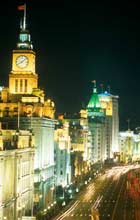
Few cities show as many contradictory aspects as westernized Shanghai. Those who glibly argue that this swinging city is all about money, not politics, should be reminded that the Chinese Communist Party was founded here. Others who see it as a city without a heart need only imagine the elation of those Jews who fled here from the Nazi Holocaust – at that time Shanghai was their only available refuge. Is Shanghai foreign or Chinese in essence, giving or grasping in nature, progressive or reactionary in politics? These are complex issues for you to ponder during your stay here.
Drugs, finance and war are, unfortunately, recurring themes in Shanghai’s turbulent history. This city’s foundation depended on this distasteful cocktail. Early in the nineteenth century, British and American trading firms sold opium to China as a means of offsetting their country’s huge and growing trade deficits. When China refused to play ball, the British sent a well armed expeditionary force to deal with the matter. In 1842, Her Majesty’s navy obliterated the quasi-medieval Chinese forces and demanded, amongst other things, the opening of five ports for international trade. One of those ports, Shanghai, was to become the most important on the Yangzi river, by 1898 servicing the equivalent of US$3.6 billion a year in British trade alone.
Extra-territoriality was a founding principle of the new city. It meant that in the American settlement, American law applied, in the British settlement, British law applied, and so on. Since these foreign territories provided much lower tax environments than China’s, it was not long before Chinese business people decamped from China proper to move their businesses and homes into the foreign concessions in Shanghai. As a result, local real estate prices sky-rocketed, and a triumvirate of financial, trade and real estate industries developed in the foreign enclaves.
However, this city, founded for opium traders, continued to depend on drugs distribution industries for its growth. By bribing foreign police forces, particularly the French one, secret gangs were also able to establish themselves in the concessions and from there control opium and heroine distribution operations. Such was the power and financial allure of these businesses that subsequent leaders of Shanghai, such as the Japanese army and the Kuomintang party, also pandered to them. After the civil war, when the Chinese Communist Party took control of Shanghai, the city’s commercial life was castrated. The drugs syndicates moved to Taiwan and Shanghai went into cold turkey.
These days, foreign business people are once more welcomed to Shanghai. Glamorous buildings are once more rising along the Huangpu river, and warm evening breezes once more carry the latest tunes. The difference is that these days it’s the Chinese who are throwing the parties.
Lying at China’s southern most point, Hainan Island has at various times been a Chinese penal colony, suffered invasion and exploitation by the Japanese, used as a port of free trade, and, in its current incarnation, is an island that China likes to compare with Hawaii. The comparison is not out of place as tourism and a naval base prop up the economies of both places.
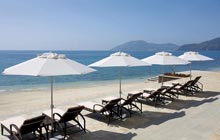 The first Chinese to settle Hainan Island were the Li people. During the Western Han Dynasty (206 BC to 24 AD), many of this Chinese ethnic minority moved from their original home in Guangxi Province to Hainan, displacing the island’s Aboriginal inhabitants.
The first Chinese to settle Hainan Island were the Li people. During the Western Han Dynasty (206 BC to 24 AD), many of this Chinese ethnic minority moved from their original home in Guangxi Province to Hainan, displacing the island’s Aboriginal inhabitants.
Originally referred to as ‘the gates of hell’, Hainan’s most famous exile was Su Dong Po, one of China’s best known literati. He was exiled to Hainan towards the end of the 11th Century for writing poetry criticizing the government. In 1098 the residents of the town that Su Dong Po resided established the Dongpo Academy in memory of him. (This was the second time he had been exiled. He was first exiled in Hangzhou where the famous pork dish Dong Po Rou was named after him. )
 During the 16th and 17th Centuries, the nation’s majority ethnic group, the Han Chinese, began to move to Hainan Island, pushing the Li people into the hilly, southern interior. Eventually the Li people rebelled, forcing the government to send in Miao minority mercenaries. Many of these Miao, originally from Guizhou Province, chose to settle in Hainan and now, these three ethnic groups make up 98% of Hainan’s population.
During the 16th and 17th Centuries, the nation’s majority ethnic group, the Han Chinese, began to move to Hainan Island, pushing the Li people into the hilly, southern interior. Eventually the Li people rebelled, forcing the government to send in Miao minority mercenaries. Many of these Miao, originally from Guizhou Province, chose to settle in Hainan and now, these three ethnic groups make up 98% of Hainan’s population.
Throughout its history, Hainan has been under the command of either Guangxi or Guangdong Provinces. The Second World War saw Japan invade and occupy Hainan for a brief period mining it for iron. At this time, the Chinese Communists and the Li Minority banded together to fight the Japanese, and, in 1950, wrested back control of the island.
In 1988, with Deng Xiao Ping opening the doors to China, the Chinese Government officially gave Hainan independent provincial status. It is from this time that the Hainan of today has developed – a tropical getaway, blessed with white sand beaches and clear blue skies, whose crescent bays are dotted with high-end international resorts. These resorts, together with secondary home real estate developments, have tilted the renown of this once purely agricultural economy away from rubber trees and fruit orchards to an international sun-seekers’ destination where affluent Chinese mix with foreigners in a place where practically everyone is on vacation.

The picturesque old town of Lijiang , with its wooden buildings, canals and bridges, sits some 8,000 feet above man and time. It is situated in north-western Yunnan Province, about 100 miles directly to the west is Myanmar (Burma), a little further to the north-west is Tibet, while directly north, past the magnificent Jade Dragon Snow Mountain, is the Chinese province of Sichuan. Lijiang lies, then, at a crossroads between different worlds, a fact strongly represented in the history, languages, and peoples of the area. While the various Silk Roads that ran from China through central Asia toward Europe are indisputably more famous, Lijiang was and is located along another famous trading route, sometimes confusingly referred to as the 'Southern Silk Road', we refer to it here by the correct designation of the 'Old Tea and Horse Route' along which moved, unsurprisingly, mainly teas and horses. Those commodities formed the backbone of an active trade for a thousand years, and were the cause of Lijiang's founding around 800 years ago, as well as much of Lijiang's relative prosperity for the ensuing centuries.
Nestled comfortably into a number of mountains to the north, and with natural watercourses making their way through the town it was always going to be a fine place for habitation. The Jade Dragon Snow Mountains which dominate the landscape have always played an important role in the town's psyche. The highest peak clears 18,000 feet and was only scaled for the first time in the 1960s. The history and man and mountain is close here. Various rites are performed on the main mountain, and its birthday is celebrated by the town on the eighth day of the second month of the lunar calendar. The mountain has also been a source of much water for the town and water usage was closely monitored. Since the whole village used the water running through the village, there were certain communal rules governing the use of water. Until noon , the water was for drinking. From 12 to 1pm , food could be washed in the stream, and from 2pm you could wash your clothes. Nowadays people brush their teeth and wash their hands in the streams, something that twenty years ago would not have been allowed.
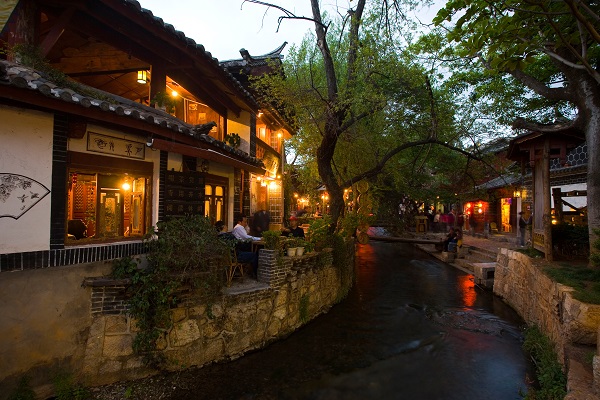
One of the features of the old town is the wooden buildings. Naxi architecture is regarded as a happy marriage of Han structures with Bai carpentry and Tibetan painting styles. Were it not for mother nature and tourism we may not see so much of the old town today. as a result of the remarkable development in the 1980s Naxi people knocked down their old wooden houses and rebuilt them in stone and cement. Then, in the 90s with the growth of the tourism industry, and a gentle hand along from a dreadful earthquake that oddly left many of the wooden buildings standing while toppling their stone neighbours, the Naxi knocked these stone imitations and rebuilt their houses with wood again.
While the stone houses came and went one cultural feature that has long been present on the streets of Lijiang is the confusion of tongues. How many languages were on the streets of Lijiang at any one time is a question with no set answer, but these days in Lijiang, if you've a linguist's ear, you'll hear Bai, Yi, Tibetan, Naxi, Mandarin, and a smattering of other languages. It'll come as no surprise then to hear that there are people from ten or so different ethnicities in the town. However, a clear majority of people, both in town and in the surrounding area of the Lijiang Basin , are from a group known as the Naxi, who came to the area sometime during the Tang dynasty (618-907).
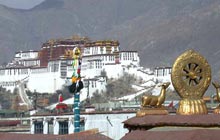 According to ancient mythology the Yarlung valley – not Lhasa – is the homeland of the Tibetan people. The first Tibetan king stepped off a heavenly ladder onto earth not in Lhasa, but here. The Yarlung valley was also the kingly seat of the first Tibetan kings as well as their burial site. This being the case, why is Tibet's capital at Lhasa rather than in the Yarlung valley?
According to ancient mythology the Yarlung valley – not Lhasa – is the homeland of the Tibetan people. The first Tibetan king stepped off a heavenly ladder onto earth not in Lhasa, but here. The Yarlung valley was also the kingly seat of the first Tibetan kings as well as their burial site. This being the case, why is Tibet's capital at Lhasa rather than in the Yarlung valley?
As with many aspects of Tibet's culture, the answer lies in her religious life. For Tibet's original Buddhist temple, dating from the seventh century, was Lhasa's Jokhang Temple , still found today pulsating at the heart of the Old Quarter. This institution, contemporaneous with the first Potala Palace , heralds Buddhism's first insemination and dissemination in a flourishing Tibetan empire stretching from western China to Nepal, Bhutan and northern India. Though its political fortunes would wax and wane, Lhasa – "the place of the Gods" – would forever thus be associated with the birth of Tibetan Buddhism . It is this birthright that would maintain Lhasa's prominence through subsequent centuries of bitter regional and religious conflict.
So it was that in the fifteenth century the ascendant Gelug monastic sect , leading a puritanical Buddhist revival in Tibet, established its three stronghold monasteries, Ganden , Drepung & Sera , in the vicinity of Lhasa. The scholarly achievements and political savvy of this sect eventually pushed Lhasa once more to center stage. Two centuries later, under the leadership of the new paramount leader of Tibet, the Great Fifth Dalai Lama , Lhasa was instituted the religious and political capital of Tibet. In 1645 the Potala Palace was re-constructed on Red Hill and the Jokhang Temple greatly expanded. Although some wooden carvings and door lintels of the Jokhang Temple date to the seventh century, the oldest of Lhasa's extant buildings, such as amidst the Potala Palace, the Jokhang and some of the monasteries and properties in the Old Quarter date to this second flowering in Lhasa's history.
The Potala Palace, uniting the political and religious roles of the Dalai Lama, neatly symbolizes the symbiotic relationship of Lhasa's religious and secular roles. This inter-dependent mapping is also seen in the routes of the city's kora or pilgrimage routes. The innermost pilgrimage route or Nangkhor is a circuit along the inside perimeter of the Jokhang Temple. The Barkhor , the best known, follows the circumference of the Jokhang Temple past other monasteries, temples and incense burners of the Old Quarter. And the last, the Lingkhor , circumambulates the city's former outer limits.
Although the Yarlung valley is indeed the mythological and historical root of the Tibetan nation, the primacy of Buddhism within the fabric of Tibetan culture has ensured that Lhasa supersedes it as the spiritual and political capital of Tibet.